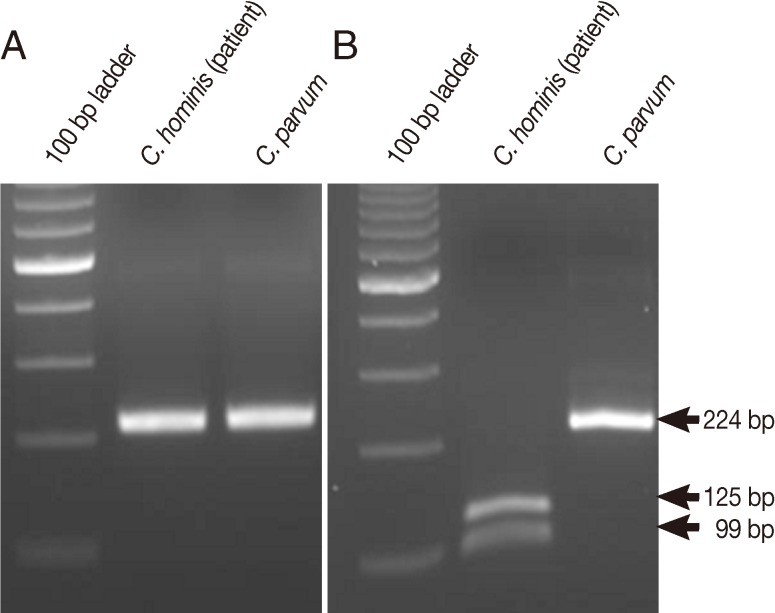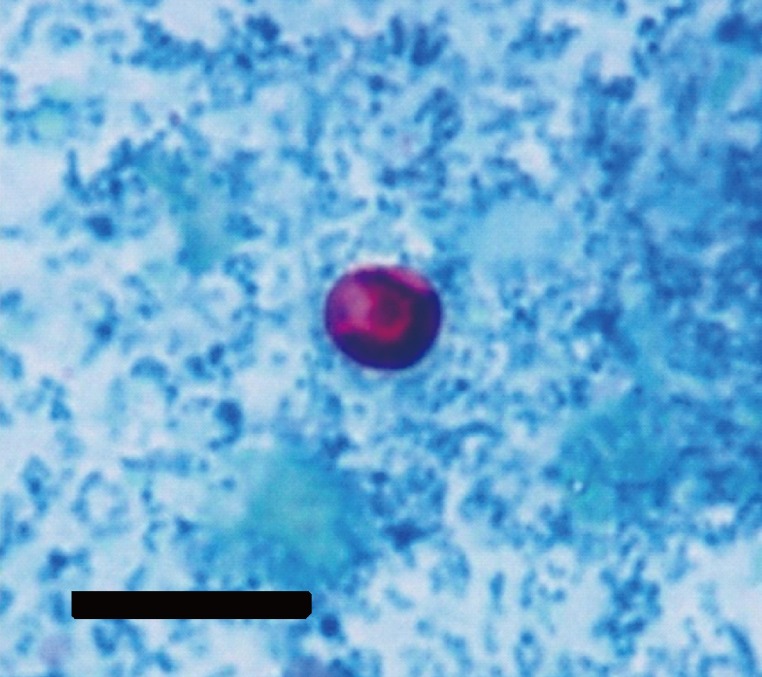Abstract
There are approximately 20 known species of the genus Cryptosporidium, and among these, 8 infect immunocompetent or immunocompromised humans. C. hominis and C. parvum most commonly infect humans. Differentiating between them is important for evaluating potential sources of infection. We report here the development of a simple and accurate real-time PCR-based restriction fragment length polymorphism (RFLP) method to distinguish between C. parvum and C. hominis. Using the CP2 gene as the target, we found that both Cryptosporidium species yielded 224 bp products. In the subsequent RFLP method using TaqI, 2 bands (99 and 125 bp) specific to C. hominis were detected. Using this method, we detected C. hominis infection in 1 of 21 patients with diarrhea, suggesting that this method could facilitate the detection of C. hominis infections.
Keywords: Cryptosporidium parvum, Cryptosporidium hominis, real-time PCR, RFLP, TaqI
Cryptosporidium parvum is a parasitic protozoan that infects gastrointestinal epithelial cells of many vertebrates, including humans [1]. It causes watery diarrhea and can be fatal to immunocompromised individuals [1]. There are 20 known Cryptosporidium species and at least 44 genotypes, which differ significantly in their molecular signatures but have not been assigned species status [2]. Eight fully characterized Cryptosporidium species (C. hominis, C. parvum, C. meleagridis, C. felis, C. canis, C. suis, C. muris, and C. andersoni) and 5 partially characterized species (from the deer, monkey, skunk, rabbit, and chipmunk) infect humans [2-5], among which C. hominis and C. parvum are the most commonly detected [3]. A real-time PCR (qPCR) method using primers derived from the CP2 gene is highly sensitive, specific, and accurate for the detection of cryptosporidiosis but cannot distinguish among species [6]. Therefore, we developed a qPCR-based restriction fragment length polymorphism (RFLP) method for the 2 Cryptosporidium spp. differentiation and we detected C. hominis in 1 of 21 patients with diarrhea.
DNA was prepared from C. parvum oocysts of (KKU isolates) collected from laboratory mice (C57BL6/J) that were infected with the parasite and maintained as described [6]. DNA was extracted from the oocysts and fecal materials by using a QIA-quick Stool Mini Kit (QIAGEN Inc., Hamburg, Germany USA). The qPCR reactions were performed according to the method of Lee et al. [6] using a LightCycler® (Roche, Basel, Switzerland, USA). The results were analyzed using the LightCycler® software (version 4.05, Roche). DNase/RNase-free water was used in place of template DNA as a negative control. CP2 sequences of C. parvum (AY471868) and C. hominis (XM_661199) were aligned using Clone Manager Suite 7 (Sci-Ed Software, Cary, North Carolina, USA), and restriction enzyme cleavage sites were identified using NEBcutter V2.0 (http://tools.neb.com/NEBcutter2/). An aliquot (15 µl) of the qPCR product was digested with TaqI (Takara Bio Inc., Shiga, Japan) at 65℃ for 2 hr, and DNA fragments were analyzed using 2.5% agarose gels. Stool samples from 21 patients with diarrhea in the Busan area of Korea were collected from June 1 to 30, 2011, by the Korea Centers for Disease Prevention and Control. Modified acid-fast staining was performed on stool samples that were positive for C. hominis by using qPCR-based RFLP.
The sequences of the CP2 genes of C. parvum (GenBank AY-471868) and C. hominis (GenBank XM_661199) are 94% identical (data not shown). Because analysis using NEBcutter V2.0 identified a TaqI site only in the sequence of C. hominis CP2 (Table 1), TaqI was chosen for restriction fragment length polymorphism (RFLP) analysis.
Table 1.
DNA fragments produced using a qPCR-based TaqI-RFLP assay for the CP2 genes of C. parvum and C. hominis

Using qPCR, we found that 1 of 21 patients with diarrhea tested was positive for CP2 (data not shown). The patient with positive results was a 6-year-old girl with watery diarrhea. No other information about the patient was available. To further identify the species of Cryptosporidium responsible for the infection, the sample was digested using TaqI, which generated 99 bp and 125 bp bands, indicating that the patient was infected by C. hominis (Fig. 1). C. hominis oocysts were also detected in the diarrheal stool sample by using the modified acid-fast staining (Fig. 2).
Fig. 1.
DNA fragments generated by TaqI digestion of real-time PCR-amplified CP2. The results are shown for fecal samples taken from 21 patients with diarrhea. C. hominis was detected in the stool samples. C. parvum isolated from laboratory mice was used as the control. (A) The qPCR product was confirmed using agarose gel electrophoresis. (B) TaqI digestion profile of the qPCR product.
Fig. 2.
Modified acid-fast staining of a stool sample of a patient infected with C. hominis. Bar=10 µm.
Morgan-Ryan et al. [7] proposed a new species of Cryptosporidium, C. hominis, to indicate its isolation from human feces. However, C. hominis and C. parvum oocysts are morphologically indistinguishable [7]. Species discrimination is important for molecular epidemiological purposes to evaluate potential sources of infections [8]. Real-time PCR increases the speed of sample analysis and decreases the risks of contamination with DNA present in the laboratory [8]. The present study showed that both major Cryptosporidium species can be detected simultaneously and distinguished from each other by using TaqI to digest the CP2 gene of C. hominis. Because the CP2 gene is highly specific, no genetic information is available for other Cryptosporidium species, except for C. parvum and C. hominis in GenBank (www.ncbi.nlm.nih.gov/genbank/).
The genotypes of Cryptosporidium in Korea have been reported [9-11]. Cheun et al. [11] studied Cryptosporidium sp. in 3 rural areas by using a PCR-RFLP method to detect 18S rDNA sequences and identified C. parvum in 12 patients with Cryptosporidium infection. Therefore, the case confirmed by the present study is very important, because it indicates the presence of C. hominis infection in Korea.
In the present study, we developed a simple and accurate qPCR-based RFLP method for differentiating C. parvum from C. hominis. This method could be helpful in facilitating the detection of C. hominis infection in Korea.
ACKNOWLEDGMENTS
This work was supported by the Basic Science Research Program of the National Research Foundation of Korea (RF) funded by the Ministry of Education, Science, and Technology (2011-3333702) and by a grant from the National Institute of Health (NIH-2010E5401000), Ministry of Health and Welfare, the Republic of Korea. The authors declare no conflicts of interest.
References
- 1.O'Donoghue PJ. Cryptosporidium and cryptosporidiosis in man and animals. Int J Parasitol. 1995;25:139–195. doi: 10.1016/0020-7519(94)e0059-v. [DOI] [PubMed] [Google Scholar]
- 2.Xiao L, Fayer R, Ryan U, Upton SJ. Cryptosporidium taxonomy: recent advances and implications for public health. Clin Microbiol Rev. 2004;17:72–97. doi: 10.1128/CMR.17.1.72-97.2004. [DOI] [PMC free article] [PubMed] [Google Scholar]
- 3.Caccio SM, Thompson RC, McLauchlin J, Smith HV. Unravelling Cryptosporidium and Giardia epidemiology. Trends Parasitol. 2005;21:430–437. doi: 10.1016/j.pt.2005.06.013. [DOI] [PubMed] [Google Scholar]
- 4.Nichols RA, Campbell BM, Smith HV. Molecular fingerprinting of Cryptosporidium oocysts isolated during water monitoring. Appl Environ Microbiol. 2006;72:5428–5435. doi: 10.1128/AEM.02906-05. [DOI] [PMC free article] [PubMed] [Google Scholar]
- 5.Feltus DC, Giddings CW, Schneck BL, Monson T, Warshauer D, McEvoy JM. Evidence supporting zoonotic transmission of Cryptosporidium spp. in Wisconsin. J Clin Microbiol. 2006;44:4303–4308. doi: 10.1128/JCM.01067-06. [DOI] [PMC free article] [PubMed] [Google Scholar]
- 6.Lee SU, Joung M, Ahn MH, Huh S, Song H, Park WY, Yu JR. CP2 gene as a useful viability marker for Cryptosporidium parvum. Parasitol Res. 2008;102:381–387. doi: 10.1007/s00436-007-0772-8. [DOI] [PubMed] [Google Scholar]
- 7.Morgan-Ryan UM, Fall A, Ward LA, Hijjawi N, Sulaiman I, Fayer R, Thompson RC, Olson M, Lal A, Xiao L. Cryptosporidium hominis n. sp. (Apicomplexa: Cryptosporidiidae) from Homo sapiens. J Eukaryot Microbiol. 2002;49:433–440. doi: 10.1111/j.1550-7408.2002.tb00224.x. [DOI] [PubMed] [Google Scholar]
- 8.Jothikumar N, da Silva AJ, Moura I, Qvarnstrom Y, Hill VR. Detection and differentiation of Cryptosporidium hominis and Cryptosporidium parvum by dual TaqMan assays. J Med Microbiol. 2008;57:1099–1105. doi: 10.1099/jmm.0.2008/001461-0. [DOI] [PubMed] [Google Scholar]
- 9.Guk SM, Yong TS, Park SJ, Park JH, Chai JY. Genotype and animal infectivity of a human isolate of Cryptosporidium parvum in the Republic of Korea. Korean J Parasitol. 2004;42:85–89. doi: 10.3347/kjp.2004.42.2.85. [DOI] [PMC free article] [PubMed] [Google Scholar]
- 10.Park JH, Guk SM, Han ET, Shin EH, Kim JL, Chai JY. Genotype analysis of Cryptosporidium spp. prevalent in a rural village in Hwasun-gun, Republic of Korea. Korean J Parasitol. 2006;44:27–33. doi: 10.3347/kjp.2006.44.1.27. [DOI] [PMC free article] [PubMed] [Google Scholar]
- 11.Cheun HI, Choi TK, Chung GT, Cho SH, Lee YH, Kimata I, Kim TS. Genotypic characterization of Cryptosporidium oocysts isolated from healthy people in three different counties of Korea. J Vet Med Sci. 2007;69:1099–1101. doi: 10.1292/jvms.69.1099. [DOI] [PubMed] [Google Scholar]




